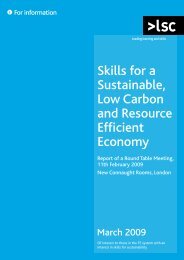Mapping the Big Green Challenge - The Skills & Learning ...
Mapping the Big Green Challenge - The Skills & Learning ...
Mapping the Big Green Challenge - The Skills & Learning ...
Create successful ePaper yourself
Turn your PDF publications into a flip-book with our unique Google optimized e-Paper software.
<strong>Mapping</strong> <strong>the</strong> <strong>Big</strong> <strong>Green</strong> <strong>Challenge</strong> 11experiment with new models, for highly motivated professionals to innovate more freely outside <strong>the</strong>state, for social movements to develop new approaches to community action, and for socialentrepreneurs to combine assets in imaginative ways. Identifying community organisations as beingformed around a shared set of values, which may operate against some aspect of mainstreamvalues, can also be seen as an on-going strength in terms of <strong>the</strong> sector’s ability to create change(Harris & Albury, 2009). <strong>The</strong> New Economics literature (e.g. Boyle, 1993) focuses on <strong>the</strong> opportunityto create spheres in which different value systems operate and this harks back to an older literatureon utopian communities (e.g. Moss Kanter, 1972). As such organisations can act as promoters ofalternative value systems and, in <strong>the</strong> broadest sense, of <strong>the</strong> possibility of living differently(something which mainstream institutions are likely to find hard to do according to writers such asJordan & O’Riordan, 1997).<strong>The</strong> 3 rd Sector is sufficiently diverse for it not to be necessary to choose between <strong>the</strong>se arguments.Instead it seems likely that both approaches might be pursued by different types of organisations orin relation to different kinds of activity. We use <strong>the</strong>se two approaches to innovation, characterisedrespectively as ‘regime’ and ‘niche’ innovation, to provide a framework for thinking about <strong>the</strong>different ways in which community organisations might support low carbon innovation.2.2 Third Sector as a Site for Within-Regime Low Carbon InnovationsRa<strong>the</strong>r than identify a particular type of innovation, arguments made from this perspective tend tojust draw on what <strong>the</strong>y see as <strong>the</strong> broad characteristics of <strong>the</strong> sector and argue that <strong>the</strong>y giveorganisations advantages in relation to ensuring wider awareness of, and commitment to, measuresto tackle <strong>the</strong> causes of climate change and, in particular, to achieve wider and more sustainedbehaviour change. <strong>The</strong> latter is particularly important given that <strong>the</strong>re are areas where wellestablished changes could have a significant impact but are not being taken up by large sections of<strong>the</strong> population. Examples of this type of perspective can be found in <strong>the</strong> Third Sector Review(Cabinet Office, 2007) which suggests that “<strong>the</strong> third sector has a critical role in engaging, enablingand encouraging wider action on climate change and <strong>the</strong> environment. … As trusted organisationswith established and growing audiences, third sector organisations are particularly powerfulcommunicators …”. Jackson (2005) argues that changing behaviour is difficult and that “communitybasedapproaches to social change are becoming an increasingly important part of <strong>the</strong> landscape ofsustainable development”. He suggests high levels of participation, particularly in <strong>the</strong> constructionof social norms which are seen as in <strong>the</strong> interests of <strong>the</strong>ir community, reinforced by monitoring and‘sanctions’, are key to a policy approach based on small group or community management. Hale(2008) argues that “individual action of <strong>the</strong> scale necessary will only emerge through collectivedecisions in <strong>the</strong> networks and communities with which people have strong personal affiliations andwhich can give <strong>the</strong>m both <strong>the</strong> motive and opportunity to act”. Harris & Albury (2009) stress thatworking at a local level “allows for a much stronger link to behaviour change” (27). Similarsentiments can be found in o<strong>the</strong>r reports including that from <strong>the</strong> Sustainable ConsumptionRoundtable (2006) which concludes “a combination of incentives, community initiatives and localfeedback will reassure people that <strong>the</strong>y are part of a collective movement that’s making adifference” and by Downing and Ballantyne (2007) who report a majority of <strong>the</strong> populationendorsing <strong>the</strong> view ‘I would do more to try to stop climate change if o<strong>the</strong>r people did more too’.Appleby Ltd July 2009











